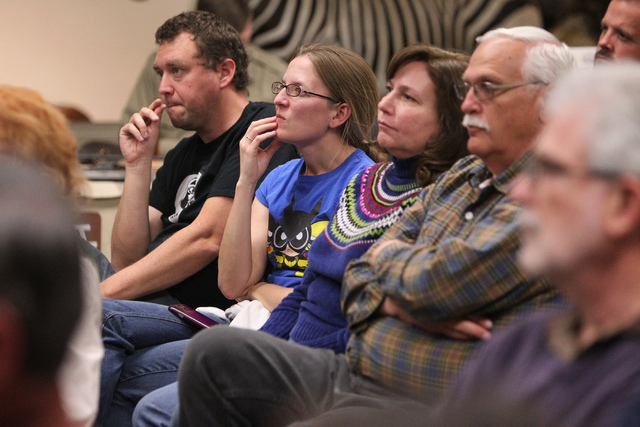Future of Nevada monument discussed in public hearing
Representations of lions, tigers, bears and scores of impressive animals border a meeting room at the Las Vegas Natural History Museum, but the dozens of curious people in attendance had other things on their minds: fossils.
Last month, federal legislation created the Tule Springs Fossil Beds National Monument within the Las Vegas Valley. Residents packed into the museum Sunday to hear about the site’s scientific history and to try to find out what the monument will be like when it comes together.
Audience members raised several good questions during the panel discussion. What will the park look like when it’s completed? How secure is the site? How will the monument help teach valley students?
This early in the planning process, which probably will take a few years, no one is too sure about what the monument will look like when completed.
“I think we need to stretch out and really be creative,” said Alan O’Neill, former superintendent of Lake Mead National Recreation Area. “This is a creative community.”
In addition to noting that the project requires public input, O’Neill said that the monument will have unique challenges and opportunities from being so close to a metropolitan area.
And security is an issue.
While parts of the site are fenced off, the northern part of the monument is a common site for illegal shooting, and people playing with ATVs and dirt bikes have long plagued the area.
Lake Mead officials have been put in charge of the monument site for now, but the speakers emphasized the need for the community to step up and take ownership of the park.
“We’re here to help, and we want the public to get out there, but it’s got to be safe for everyone,” Jill DeStefano said.
DeStefano serves as president of the Protectors of Tule Springs nonprofit group. POTS has been advocating for the monument since 2006. Members give guided tours to special groups and sometimes act as the park’s eyes and ears in the absence of law enforcement.
“We could certainly use more volunteers,” DeStefano said.
Destafeno also said that, as a teacher with the Clark County School District, she is looking for ways to make sure every student in the valley has the chance to learn at the park.
In the past, nearby high schools have had the chance to use the dig sites as living laboratories for earth science classes. Boy Scout troops have used the park to earn their geology and paleontology badges. All of the speakers agreed that the thrill of seeing fossils at Tule Springs will be exciting and encouraging to all students.
“I want every Clark County school child to be out there,” she said.
But the first step, according to the speakers at the event, is educating the public and getting them involved.
Professors Steve Rowland and Josh Bonde of the University of Nevada, Las Vegas started the event with short presentations on the site’s history as a major dig site.
Tule Springs gained paleontological prominence after an obsidian flake was discovered in 1933. Early humans used the mineral in tools, but it’s not native to the region. Other findings, like the fossils of ancient mammoths and camels, offered scientists a unique opportunity to figure out when humans came to North America and how they interacted with ice-age animals.
Excavation continued at the site through the 1960s, culminating in a 1967 research report.
“Still to this day, much of what we know of Pleistocene (the most recent ice age) life comes from that,” Rowland said.
Bonde said the site is important because scientists haven’t figured everything out yet. And there seems to be no shortage of fossils and new discoveries buried in that stretch of desert.
Bonde said 25 new fossil sites were discovered in just one week while he was helping to survey the area, including the first evidence of the presence of dire wolves in Nevada.
There’s lots of research to be done,” he said. “By no means are we running out of fossils anytime soon.”
Fossils from Tule Springs can be viewed in at the Las Vegas Natural History Museum, 900 Las Vegas Blvd. North, and the Old Las Vegas Mormon Fort, 500 E. Washington Ave.
For those who would like to get involved, POTS is having a meeting with Lake Mead officials for volunteers at North Las Vegas’ Aliante Library, 2400 Deer Springs Way, at 6 p.m. Tuesday.
Information about upcoming public hearings can be found on the Tule Springs Fossil Beds National Monument Facebook page at www.facebook.com/TuleSpringsNPS.
Contact Wesley Juhl at wjuhl@reviewjournal.com and 702-383-0391. Find him on Twitter: @WesJuhl.
























